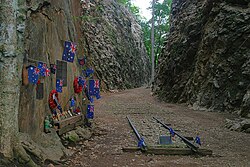Hellfire Pass
ช่องเขาขาด | |
 A portion of Hellfire Pass | |
| Established | 24 April 1996 |
|---|---|
| Location | Kanchanaburi Province, Thailand |
| Type | War memorial, nature trail & abandoned railway line |
| Curator | Office of Australian War Graves/Royal Thai Armed Forces |
| Public transit access | Nam Tok Sai Yok Noi railway station (18 kilometres (11 mi) away) |

Hellfire Pass (Template:Lang-th, known by the Japanese as Konyu Cutting) is the name of a railway cutting on the former "Death Railway" in Thailand which was built with forced labour during the Second World War, in part by Allied prisoners of war. The pass is noted for the harsh conditions and heavy loss of life suffered by its labourers during construction. Hellfire Pass is so called because the sight of emaciated prisoners labouring at night by torchlight was said to resemble a scene from Hell.[1]
History
Hellfire Pass in the Tenasserim Hills was a particularly difficult section of the line to build. It was the largest rock cutting on the railway, coupled with its general remoteness and the lack of proper construction tools during building. A tunnel would have been possible to build instead of a cutting, but this could only be constructed at the two ends at any one time, whereas the cutting could be constructed at all points simultaneously despite the excess effort required by the POWs. The Australian, British, Dutch and other allied Prisoners of War were required by the Japanese to work 18 hours a day to complete the cutting. Sixty nine men were beaten to death by Japanese guards in the six weeks it took to build the cutting, and many more died from cholera, dysentery, starvation, and exhaustion (Wigmore 568).[2] However, the majority of deaths occurred amongst labourers whom the Japanese enticed to come to help build the line with false promises of good jobs. These labourers, mostly Malayans (Chinese, Malays and Tamils from Malaya), suffered mostly the same as the POWs at the hands of the Japanese. The Japanese kept no records of these deaths.
The railway was never built to a level of lasting permanence and was frequently bombed by the Royal Air Force during the Burma Campaign. After the war, all but the present section was closed and the line is now only in service between Bangkok and Nam Tok Sai Yok Noi.
Present day
There are no longer any trains running on this stretch of the line. The nearest railway station is at Nam Tok Sai Yok Noi, where trains of the State Railway of Thailand can be taken for a trip over the famous Whampo Viaduct and across the bridge over the River Kwai to Kanchanaburi, which is the nearest major town and tourist base. Visitors to the museum usually base themselves in Kanchanaburi. It is possible in one day to visit the Erawan Waterfall in the morning, followed by a visit to Hellfire Pass and its museum in the afternoon, and then catch the train back to Kanchanaburi to cross the famous bridge around sunset.
Museum
There is a museum co-sponsored by the Royal Thai Armed Forces Development Command and the Australian government at the site to commemorate the suffering of those involved in the construction of the railway. It was built by the Office of Australian War Graves and opened by the then Prime Minister of Australia, John Howard. As a part of the museum experience, it is possible to walk through the cutting itself and along a section of the former railway track bed. An audio tour including recorded memories of surviving POWs is available at the museum.[3]
Recent developments
In 2006, proposals to create a railway network linking eight south-east Asia countries would see a railway link restored between Thailand and Myanmar. It is not clear if this would follow the original Death Railway route through Hellfire Pass, since this route was necessarily built quickly and to low standard of curves and gradients.[4]
References
- ^ Thailand. Lonely Planet. 2007. p. 219. ISBN 978-1-74104-307-5.
{{cite book}}:|access-date=requires|url=(help); Unknown parameter|authors=ignored (help) - ^ "Railway of Death: Images of the construction of the Burma–Thailand Railway 1942–1943". Anzac Day. ANZAC Day Commemoration Committee of Queensland. Retrieved 31 August 2010.
- ^ "Hellfire Pass Museum". Hellfire Pass Tours. Retrieved 30 August 2010.
- ^ Trans-Asia railway planned, VietNamNet Bridge.
Further reading
- The Japanese Thrust — Australia in the War of 1939–1945, Lionel Wigmore, AWM, Canberra, 1957.
- Authenticated Records from Japanese POW camps along the Thai-Burmese railway 1942–45, second floor, Research library, Thai-Burma Railway Centre, Kanchanaburi, Thailand, 2008.
- Prisoners of the Japanese - POWs of World War II in the Pacific, Gavan Daws
- 1940s in Thailand
- Geography of Kanchanaburi Province
- World War II prisoner of war camps
- Japanese war crimes
- Railway cuttings
- History of rail transport in Thailand
- World War II museums
- Australian military memorials
- Military and war museums in Thailand
- Railway museums in Thailand
- History museums in Thailand
- Visitor attractions in Kanchanaburi Province
- Buildings and structures in Kanchanaburi Province

